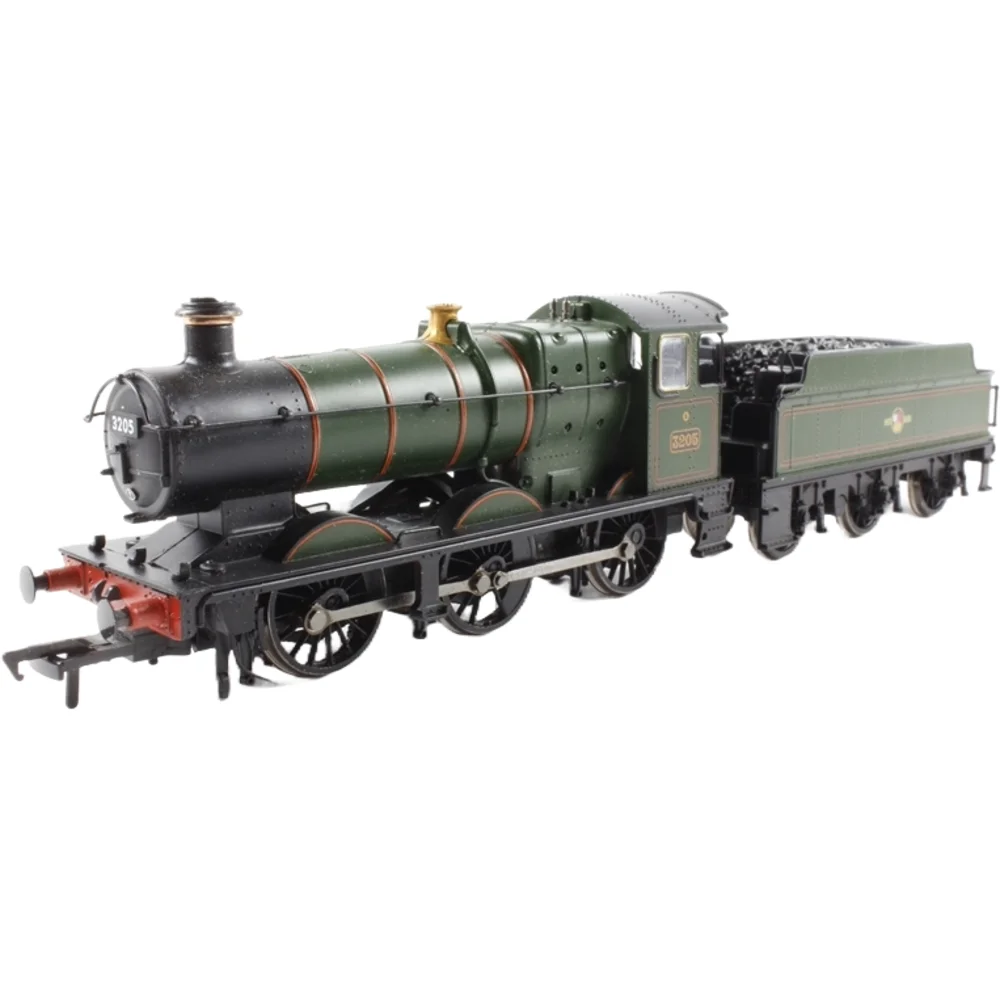Bachmann 30-052
Great Western Railway 2251 3205 British Railways Lined Green with Late Crest
Tooling
In 2007, Bachmann Branchline introduced a major upgrade to its GWR 2251 Class (Collett Goods) model. This revision replaced the earlier 1998 tooling and brought the locomotive up to modern standards for detailing and digital control. The prototype 2251s were designed by Charles Collett for the Great Western Railway in 1930 and served as versatile 0-6-0 tender engines for freight and secondary passenger duties. The 2007 tooling marked Bachmann’s transition to fully DCC-ready specifications and improved fidelity to the prototype.
Tooling Features
- Scale: OO gauge (1:76 scale).
- Construction: High-quality plastic bodyshell with separately fitted details, die-cast chassis for strength and weight.
- Detailing: Enhanced cab interior, fine rivet and boiler detail, separately applied handrails, accurate tender variations (Collett and Churchward types).
- Couplings: NEM pockets with tension-lock couplers.
Mechanical & Electrical
- Motor & Drive: Smooth-running motor with worm-and-gear drive to all driving wheels.
- Minimum Radius: Second radius curves (approx. 438 mm).
- Lighting: No factory-fitted lighting.
- Weighting: Die-cast chassis provides good traction for freight duties.
DCC Capability
- Fully DCC Ready with an 8-pin socket as standard.
- Some later releases included factory-fitted decoders marketed as “DCC On Board.”
Liveries Produced
The 2007 tooling appeared in a range of authentic liveries, including:
- GWR Green (pre-1947 styles).
- BR Black with Early Emblem (circa 1949–1957).
- BR Lined Green with Late Crest (post-1957).
Reviews & Commentary
The upgrade was widely praised for its improved accuracy and ease of DCC conversion. Reviewers highlighted the fine cab detail, better tender proportions, and smooth running performance. Compared to the earlier 1998 tooling, the 2007 version offered superior finish and modern digital compatibility. Minor criticisms included the absence of factory lighting and limited weathered options in initial runs.
Media & Social Media
The model has featured in numerous YouTube reviews and enthusiast forums, often commended for its reliability and suitability for branch line layouts. Videos showcasing sound-fitted versions and preserved prototype No. 3205 have reinforced its popularity among GWR modellers.
Interesting Notes
- The 2007 tooling represented Bachmann’s move toward its “Blue Riband” standard for steam locomotives.
- Variants included different tender types and occasional weathered finishes to reflect prototype diversity.
Class & Prototype
- Class: Great Western Railway 2251
- Traction: Steam
- Built: 1930-1948
- Total Built: 120
- Running Number: 3205
Operator & Livery
- Operator: British Railways
- Livery: Lined Green with Late Crest
- Era: 5 - British Railways Late Crest
British Railways transformed Britain's fragmented rail network into a unified national system following nationalisation on 1st January 1948. Created from the "Big Four" companies under the Transport Act 1947, BR operated most of Great Britain's railways until rebranding as British Rail in 1965, managing over 20,000 route miles and inheriting nearly 20,000 locomotives of diverse designs.
The organisation pioneered standardisation through its revolutionary BR Standard locomotive programme (1951-1960), producing 999 advanced steam engines under Robert Riddles' direction. These included the versatile Britannia Pacifics, mighty 9F freight engines, and mixed-traffic classes that incorporated the best features from all predecessor companies. The 1955 Modernisation Plan accelerated diesel and electric traction development, creating fascinating mixed-traction operations.
Notable achievements included establishing unified locomotive classification systems, introducing distinctive corporate liveries, and managing the complex transition from steam to modern traction. BR's six regional structure preserved operational diversity whilst enabling standardisation of practices, signalling, and rolling stock that had eluded private enterprise for over a century.
The BR era represents steam traction's final flowering alongside emerging diesel technology, creating unparalleled locomotive variety. Today, this heritage remains highly popular with railway enthusiasts through extensive preserved fleets, heritage railway operations, and comprehensive model ranges from manufacturers like Hornby, Bachmann, and Dapol, making BR subjects essential for authentic post-war British railway modelling across all scales.
British Railways' lined green livery continued for express passenger locomotives from 1956, painted in BS224 Deep Bronze Green (also known as Land Rover Deep Bronze Green) with orange and black lining, maintaining the prestigious finish for the railway's premier motive power. The livery was reserved for the most powerful express passenger classes, including Britannias, Castles, Kings, A4s, Merchant Navy Pacifics, and other premier locomotives rated for top-link express duties. From 1954 onwards, green became more widely adopted across the locomotive fleet, with some mixed-traffic engines also receiving the prestigious finish as regional freedom in livery matters increased following the 1953 Transport Act.
From mid-1956, these locomotives received the new "Lion and Crown" emblem (nicknamed the "Ferret and Dartboard"), a proper heraldic device registered with the College of Arms featuring a rampant lion emerging from a crown and holding a spoked wheel, all enclosed in a roundel with "British Railways" on bars either side. The emblem was positioned centrally on tender sides, with the heraldically correct lion facing left, though some locomotives initially received forward-facing applications during the transition period. Lettering and numbering remained in golden yellow Gill Sans Medium, maintaining the high-quality finish appropriate for express passenger duties. Regional variations in the shade of green occurred depending on which works applied the paint, the suppliers used, and the number of paint layers applied, creating subtle differences between locomotive classes and individual engines. This livery represented the final flowering of BR's steam-era corporate identity, combining technical excellence with heraldic dignity during the twilight years of express steam operations before the Rail Blue revolution of the mid-1960s.
